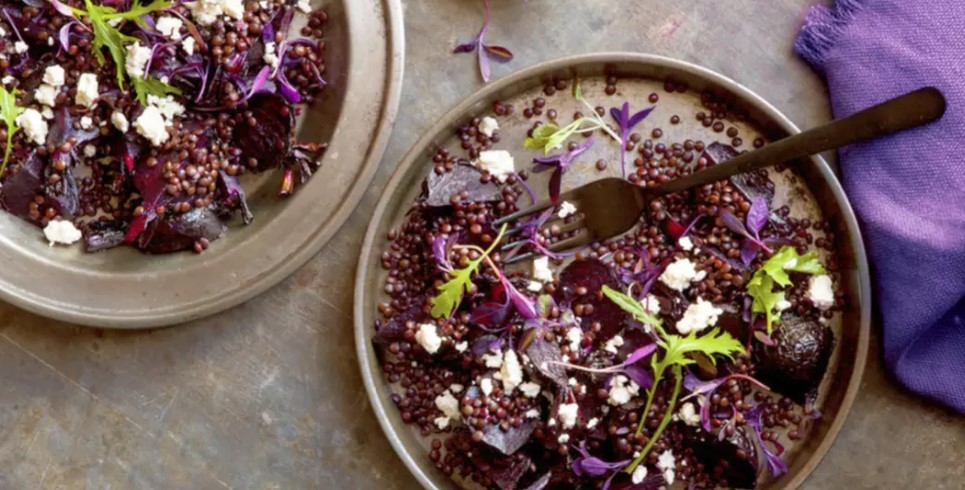
Tracye McQuirter, a vegan lifestyle expert, is in her 40s—and in her new book, Ageless Vegan, she teams up with her 80-year-old mother, Mary, to share the secrets to feeling and looking amazing, no matter what year you were born. Tracye, the author of the ground-breaking By Any Greens Necessary—the first vegan guide for African-American women—has been a vegan for over 30 years, and it’s completely transformed her health and life. In this excerpt, she shares the five food rules she follows to feel great every day.
People tend to think that going vegan means committing to a lifetime of confusing and laborious meal prep. But it doesn’t have to be complicated. When choosing what to eat each day, my mom and I just follow a few simple food principles. These are the five we abide by to make sure the food we’re eating is nutritious, delicious, and easy.
1. Keep a healthy base
We make sure to eat these central types of whole plant-based foods every day: fruits; vegetables; whole grains; and beans, nuts, and seeds. Creating our meals from these foods gives us unlimited ways to enjoy healthy, great-tasting dishes that meet all of our nutritional needs.
Here’s what that looks like:
FRUITS: 2 cups daily.
One cup is about the same as a piece of fruit, like a banana, orange, apple, grapefruit, or pear. It’s also the same as a cup of blueberries, grapes, or strawberries (or about eight large strawberries) or a cup of chopped fruit. For dried fruits, like raisins and dried apricots, it’s about a half cup each day.
VEGETABLES: 2½ cups daily.
One cup is about the same as ten broccoli florets, twelve baby carrots, one large sweet potato, 1 cup of sliced beets, 1 cup of chopped zucchini, or 1 cup of sautéed collard greens. And 2 cups of raw, dark leafy greens are considered the equivalent of 1 cup of vegetables. (More on dark leafy greens, below.)
WHOLE GRAINS: 1½ cups daily.
It’s pretty easy to eat a cup and a half of cooked oatmeal, black rice, quinoa, millet, or whole-grain pasta each day. One slice of whole-grain bread or one whole-grain tortilla is also the equivalent of ½ cup of whole grains. So eating just one sandwich gets you two-thirds of the way to your daily recommended intake.
BEANS, NUTS, AND SEEDS: 1½ cups of beans and ¼ cup of nuts daily.
Eating a cup and a half of beans each day could include a hot bowl of soup made from lentils, black beans, or split peas. And almonds, walnuts or cashews can be tossed into a morning smoothie.
2. Keep your balance
We create well-balanced meals. Whether in a breakfast smoothie, a lunch salad, or a dinner stir-fry, we make sure to eat a main source of protein (from beans or nuts), healthy fats (from nuts), and complex carbohydrates (from whole grains, vegetables, and fruits).
What does that look like in practice? For a typical 9-inch plate, you want to fill half with fruits and vegetables, one quarter with beans, and the other quarter with whole grains. Even with a wrap, burrito, or soup, you want to include fruits (remember, tomatoes are technically fruits), vegetables, whole grains, and beans.
3. Health is in the hue
We make sure our meals reflect the rainbow of colors in fruits, vegetables, whole grains, beans, and nuts. The colors or pigments in plant-based foods come from phytochemicals. These phytochemicals are protective compounds that provide numerous health benefits, from helping to prevent and reverse our major chronic diseases, including heart disease, cancer, stroke, and diabetes, boosting our immune system, and aiding in digestion. So the health is in the hue—and the darker and brighter the color, the greater the health benefits.
Want to get the health benefits of the food rainbow each day? Well, you’re probably already eating at least some brightly colored foods every day. An orange, tomatoes, carrots? Just start upping your game by including at least two to three bright colors at each meal, from red beans to purple eggplant, to yellow squash.
4. By any greens necessary
We eat dark leafy greens two to three times a day, since they provide the most nutrition of all foods. My mother and I each eat about one standard bunch of greens or 12 to 15 leaves per day. I believe that this is one of the keys to our health and longevity, in addition to eating whole foods.
Try to eat at least 4 cups of dark leafy greens every day—it’s not as hard as you might think. Here’s what that might look like:
MORNING DRINK: Add 1 to 2 cups of fresh or frozen spinach or kale to a fruit smoothie.
LUNCH: Have 2 cups of kale, arugula, dandelion greens, or other combination of dark leafy greens be the foundation of your salad.
DINNER: Add very thinly chopped chard as a garnish to the other types of vegetables you have for dinner.
5. Small is all
We eat four to five small meals throughout the day, rather than three large meals. We’ve found that this helps us maintain our energy levels.
Here’s what our day on a plate usually looks like:
MORNING: Green smoothie
MID-MORNING: Oatmeal with nuts and fruit
LUNCH: Soup and salad
MID-AFTERNOON: Hummus and avocado with whole-grain crackers
DINNER: Vegetable wrap or veggie pizza.

